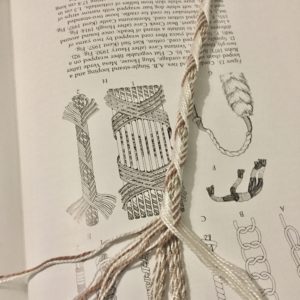 Laura discovered weaving during a fourth grade field trip to an 18th century house with an antique barn frame loom – her first weaving lesson, fittingly, occurred at another such loom. An experimental archaeology lecture during her semester in Germany introduced her to tablet weaving; the discovery that weaving could be accomplished with minimal equipment sent her on a path of exploration that eventually led to obtaining a degree in Fibers at Oregon College of Art & Craft and acquiring a great many books. She loves to share low-tech fiber techniques at demos and workshops.
Laura discovered weaving during a fourth grade field trip to an 18th century house with an antique barn frame loom – her first weaving lesson, fittingly, occurred at another such loom. An experimental archaeology lecture during her semester in Germany introduced her to tablet weaving; the discovery that weaving could be accomplished with minimal equipment sent her on a path of exploration that eventually led to obtaining a degree in Fibers at Oregon College of Art & Craft and acquiring a great many books. She loves to share low-tech fiber techniques at demos and workshops.
 Prehistoric Southwestern Textiles
Prehistoric Southwestern Textiles
The dry conditions and sheltered locations of many archaeological sites in the deserts of the southwestern United States have preserved an intriguing array of textiles made in a range of structures both simple and complex, including twining, interlinking, plain weave, twill, and tapestry. Surviving examples include quivers, nets, garments, blankets, tumplines, and bags, as well as many fragments. The variety of surviving fiber materials—including fur and feathers, bast fibers and cotton—attests to the ingenuity of the prehistoric southwestern people as well as their intimate knowledge of their environment. This seminar will survey some of these fascinating textiles, discussing fibers, evidence for dyes, and especially techniques and design principles.
